Canal wall-down (CWD) mastoidectomy is a surgical procedure that, in its most common application, involves removal of the superior and posterior bony external auditory canal wall such that a continuous open cavity is formed consisting of the external auditory canal lumen, epitympanum, and open mastoid cavity (▶ Fig. 35.1).1 This procedure is employed primarily for the indication of cholesteatoma as a means to obtain wide exposure and access to the tympanomastoid air cell tracts for disease removal; however, it also provides the benefit of exteriorizing areas that are involved with cholesteatoma so that they can be monitored in the office setting without concern for cholesteatoma recurrence or intracranial complication. Fig. 35.1 CWD mastoidectomy. (a) The MRM (right ear) is a CWD mastoidectomy procedure that involves exteriorizing the epitympanum and mastoid cavity in continuum with the external auditory canal while preserving a middle ear space by reconstructing the tympano-ossicular mechanism. (b) In contrast, the RM exteriorizes the entire tympanomastoid space without tympano-ossicular reconstruction. (Used with permission from Atlas M, Eisenberg R. A Guide to Temporal Bone Dissection. 2nd Ed. Perth: Lions Ear & Hearing Institute; 2004.) There are three main subtypes of CWD procedures: The radical mastoidectomy (RM) exteriorizes the entire tympanomastoid compartment, often with plugging of the Eustachian tube. The middle ear cleft is allowed to epithelialize without an attempt at reconstruction of the tympano-ossicular mechanism; thus, resulting hearing is poor. The modified radical mastoidectomy (MRM) usually exteriorizes only the epitympanum and the mastoid cavity. The tympano-ossicular mechanism is reconstructed in some form such that a middle ear space is preserved, albeit with a smaller volume. MRM is by far the most common form of CWD mastoid surgery and one that affords the possibility of good hearing. Some surgeons believe that this procedure should be termed CWD mastoidectomy with tympanoplasty, reserving the designation MRM only for Bondy’s procedure (discussed below); however, this point is not universally agreed upon. It is important to recognize that MRM is fundamentally different from the epitympanectomy techniques that are described in Chapter 34 of this book. The Bondy modified radical mastoidectomy (BMRM) may be applied to those small lateral epitympanic cholesteatomas present in a scenario with three distinct features: the mesotympanum is spared, the ossicular chain is intact, and the canal wall is drilled down. After removal of the bony canal wall, the cholesteatoma is either marsupialized into the open cavity, with the medial aspect of the sac left in place on the ossicular chain, or removed completely, followed by placement of a fascia graft directly onto the incus body and malleus head. As a result, the mastoid cavity and lateral aspect of the epitympanum are exteriorized, with the ossicular chain and majority of the middle ear space preserved. Although BMRM is rarely performed, hearing results are typically excellent (▶ Fig. 35.2). Fig. 35.2 Bondy modified radical mastoidectomy (BMRM). The BMRM (right ear) is a CWD mastoidectomy procedure that involves exteriorizing the lateral epitympanic space and mastoid cavity while preserving the ossicular chain. This is achieved by either marsupializing the cholesteatoma, with the portion of the sac in contact with the ossicular chain left in place, or by removing the cholesteatoma sac and placing a fascia graft onto the lateral aspect of the ossicular chain. (Used with permission from Atlas M, Eisenberg R. A Guide to Temporal Bone Dissection. 2nd Ed. Perth: Lions Ear & Hearing Institute; 2004.) The indications for CWD surgery are controversial, differing from surgeon to surgeon.2,3,4,5 Some advocate CWD surgery for all cases of cholesteatoma due to a superior track record with respect to lower rates of residual and recurrent cholesteatoma compared with canal wall-up (CWU) mastoidectomy. Other surgeons favor CWD surgery in the sclerotic temporal bone or when complications of cholesteatoma due to bone erosion are present, such as labyrinthine fistula, facial nerve involvement, or dura involvement. CWD surgery may also be indicated in a patient who is not deemed to be a good candidate for second-look surgery following CWU mastoidectomy due to poor health or suspect patient compliance.6 In the authors’ view, the primary indication for CWD mastoid surgery is quite simply to provide access for definitive cholesteatoma removal. The underlying disease extension, the patient’s temporal bone anatomy, and the surgeon’s experience and training will influence this decision. Removal of the canal wall facilitates a panoramic view of the epitympanum and particularly augments exposure to the supralabyrinthine air cells, the anterior epitympanic region, the supratubal recess, and the protympanum by opening the surgical angles that define the posterior-to-anterior surgical vantage point. Whether or not CWD surgery provides improved access to the posterior mesotympanum (particularly the sinus tympani) is controversial. In a randomized trial in cadaveric temporal bones, Hulka et al. found improved visualization of this region with CWD exposure as opposed to CWU exposure.7 In the authors’ opinion, visualization of the posterior mesotympanum may be achieved with a CWU approach in a way that is comparable to CWD surgery if the surgeon purposefully drills the scutum and posterior canal wall bone sufficiently enough to view the entire pyramidal process and ponticulus (often as far as the mastoid segment of the facial nerve), and if the surgeon assumes a far anterior vantage point. However, it is also the authors’ opinion that, although visualization of this key area may be comparable, actual surgical dissection of the posterior mesotympanum is much easier with a CWD approach due to the fact that wide lateral access of instruments into the middle ear is better afforded, thereby facilitating deft cholesteatoma dissection. Also, drilling away the bone anterior to the mastoid segment of the facial nerve, a maneuver that opens the view into the vestibule of the sinus tympani, is much more effective with CWD exposure. It should also be noted that access to and removal of disease from the sinus tympani is impacted by its size and by the degree of pneumatization in this region. The aim of cholesteatoma surgery is to create a safe, dry, and hearing ear. A safe ear is free of recurrent and residual cholesteatoma. A dry ear has an intact migrating epithelium that is waterproof. Hearing is dependent on many factors, but the mastoid cavity may need to be able to accommodate a hearing aid, especially if there is a mixed hearing loss. Successful CWD surgery achieves all of these aims; however, this is heavily dependent on a surgeon’s ability to construct an ear that resists retention of keratin debris and moisture as these lead to foreign body reactions, aural polyp, granulation tissue, and microbial overgrowth.8,9 Assessment and management of the mastoid cavity in the clinic setting, including a discussion of cavity instability, is covered in Chapter 14. A common fundamental mistake among novice cholesteatoma surgeons is to consider CWD surgery as essentially the same as CWU mastoidectomy with the simple addition of bony canal wall removal. This error often leads to a cavity that is designed to fail (▶ Fig. 35.3). Consistently good outcomes in CWD mastoidectomy require an understanding that an optimal CWD technique requires several additional steps after cholesteatoma removal that not only generate proper shape and contour, but also match the caliber of the external auditory meatus with the size of the cavity.10 Fig. 35.3 An unfavorable versus a properly formed canal wall-down mastoidectomy. (a) In the unfavorable cavity note the steep non-saucerized edges, the potholes from residual air cells, the intact open mastoid tip with debris, the uncontoured tympanic bone forming a kidney-shaped cavity, the high facial ridge. A, steep non-saucerized edges; B, potholes from residual air cells; C, intact open mastoid tip with debris; D, uncontoured kidney-shaped tympanic bone; E, high facial ridge; (b) Also note the tympanic membrane perforation, and the unsealed communication between the mesotympanum and the exteriorized epitympanum. F, tympanic membrane perforation; G, unsealed communication with epitympanum. (c) In contrast, the properly formed canal wall-down mastoidectomy features saucerized edges, a mastoid tip that has been amputated from the digastric muscle, air cells that have been drilled away until the smooth posterior and middle fossa dural plates are exposed, a completely lowered facial ridge, a inferior tympanic bone that has been rendered concave having a smooth junction with the mastoid, an intact tympanic membrane, and an intact seal between the epitympanum and the mesotympanum. A, saucerized edges; B, mastoid tip amputated from digastric muscle; C, cells drilled away up to smooth dural plate; D, facial ridge lowered; E, tympanic bone smoothly fractured with junction of mastoid; F, intact tympanic membrane; G, middle ear sealed from epitympanum. A desired aim in cholesteatoma surgical exposure is to view the entire lateral aspect of the cholesteatoma sac before proceeding with removal, as this will maximize the chance of complete removal while avoiding piecemeal dissection. For primary acquired epitympanic cholesteatoma, this involves isolation of the neck of the cholesteatoma sac at the junction with the tympanic membrane by progressively removing adjacent canal wall bone starting at the eroded scutum. As the origin of the sac is clearly delineated, it can then be amputated from the remnant tympanic membrane, which will facilitate elevation of a tympanomeatal flap, middle ear exploration, and confirmation that the incudostapedial joint has been eroded or disarticulated (to avoid iatrogenic noise-induced hearing loss during the drilling phase). Keeping the goal of wide lateral sac exposure in mind, a stepwise approach to CWD mastoidectomy drilling then begins. First, the tegmen mastoideum, sigmoid sinus, and digastric ridge are broadly skeletonized. In doing so, the central mastoid air cell tract is drilled, Korner’s septum is penetrated, and the mastoid antrum is entered. The mastoid segment of the facial nerve is then carefully identified under copious irrigation using the horizontal semicircular canal and digastic ridge as useful landmarks. The superior and posterior canal wall bone is then progressively removed, including elimination of the facial recess and chorda tympani nerve. Dissection then proceeds with skeletonization of the tegmen tympani and drilling into the zygomatic air cells to complete removal of the entire lateral epitympanic wall. One of the major advantages of a CWD approach compared with CWU surgery is the ability to widely open the anterior epitympanic communication into the supratubal recess, as this is a critical site of cholesteatoma invasion (▶ Fig. 35.4). This involves identification of the cog, amputation of the malleus head, and drilling open the anterior epitympanic bone into the prominent anterior epitympanic air cell (epitympanic sinus). In doing so, the mucosal fold of the tensor tympani is taken down, and the supratubal recess is rendered widely continuous with the epitympanum. If necessary, the dissection can then proceed inferiorly with removal of the anterior tympanic spine and anterior-superior tympanic ring to expose the protympanum. Fig. 35.4 Exposing the anterior epitympanum and supratubal recess. One major advantage of CWD mastoid surgery is enhanced exposure of the anterior epitympanum. Often, this requires release of the residual tympanic membrane and malleus from the anterior tympanic spine to allow drilling of the anterior-superior aspect of the tympanic ring and smooth contouring of the anterior buttress, which constitutes the transition from the native external auditory canal bone to the epitympanum. During dissection in this region it is commonplace for many surgeons to indiscriminately cut the tensor tympani tendon and/or to remove the malleus. Although this step is unavoidable in many cases, the authors’ bias is to endeavor to preserve the entire manubrium and at least a single ligamentous anchoring malleus attachment (among the anterior malleal ligament or tensor tendon) when the extent of cholesteatoma makes this reasonably feasible. Benefits of partial malleus preservation include the following: 1) aiding wound healing as the umbo is the epicenter of tympanic membrane keratinocyte proliferation11; 2) serving as an anchor for the drumhead to prevent lateralization; and 3) acting as a stabilizing focus during ossiculoplasty. In most cases, it is possible to obtain excellent exposure while preserving the tensor tendon by releasing the anterior malleal ligament, elevating the anterior-superior tympanic membrane annulus, retracting the malleus and attached remnant drumhead posteriorly, and drilling away the exposed anterior tympanic spine. The final stage of cholesteatoma exposure involves removal of bone from the anterior border of the facial nerve within the tympanic cleft. This final maneuver will improve access to the posterior mesotympanic wall, including the vestibule of the sinus tympani. Once cholesteatoma is removed, attention is then given to extirpate all diseased air cells, with particular attention given to the perilabyrinthine, retrosigmoid, and retrofacial groups. After the process of CWD cholesteatoma removal is complete, a raised ridge of bone may remain partially overlying the mastoid segment of the facial nerve. Incomplete lowering of this facial ridge has been shown to have perhaps the greatest negative effect on mastoid cavity stability than any other surgical error (▶ Fig. 35.5).12 A high facial ridge is defined as having bone overlying the facial nerve that is 2 mm or greater in thickness although lowering the ridge less than this is commonly desired.13 The effect of a high ridge is to create a steep “cliff” within the cavity that promotes posterior accumulation of debris and hinders centrifugal epithelial migration. Fig. 35.5 Lowering the facial ridge. The facial ridge is lowered by removing the bone lateral to the mastoid segment of the facial nerve. A high facial ridge (a) is compared with a low ridge (b). Proper lowering of the facial ridge (radical mastoidectomy) is achieved by skeletonizing the nerve with a thin residual rim of bone (<2 mm) from the second genu to the chorda tympani-facial nerve junction (c). In doing so, progressive removal of the chorda tympani nerve will act as a helpful guide. As part of this process, the tympanic bone anterior to the nerve is rendered concave having a smooth junction with the mastoid cavity. To properly lower the facial ridge, the mastoid segment of the facial nerve is clearly identified from the second genu to the distal fanned-out aspect of the Fallopian canal that constitutes the stylomastoid foramen. If present, any residual chorda tympani nerve is then identified by drilling away any remnant bone lateral to the facial nerve (facial recess). In doing so, the process of lowering the ridge is executed by following and removing the chorda tympani remnant until passage just distal to the chorda-facial junction is complete. This point usually lies just inferior to the tympanic annulus. The tympanic bone is a vital part of the petrous temporal bone that should be given particular attention during CWD surgery. The anterior and inferior external auditory canals include the tympanic bone and must be removed to create a concave smooth junction with the adjacent mastoid. The non-contoured tympanic bone has been described as a “kidney shape” that, similar to a high facial ridge, has been shown to impart a major negative impact on the likelihood of mastoid cavity stability.12 To achieve proper contour, drilling of the tympanic bone is undertaken anterior and lateral to the distal aspect of the facial nerve (▶ Fig. 35.6). Typically, there is a convex, pyramid-shaped segment of tympanic bone that must be rendered concave to create a junction into the mastoid cavity. The apex of such a pyramid acts as the midline hilum of an imaginary kidney or bean and should be eliminated. As with lowering of the facial ridge, this step is performed under copious irrigation with an extra-course diamond burr. Fig. 35.6 Contouring the tympanic bone. (a) Drilling of the tympanic bone inferior to the tympanic ring and anterior to the facial nerve is necessary to eliminate the “kidney shape” of the resultant cavity and to provide a smooth junction between the native external auditory canal and mastoid cavity. (b) The prominent convex point at the apex of the undrilled native tympanic bone (asterisk) must be rendered convex and saucerized.
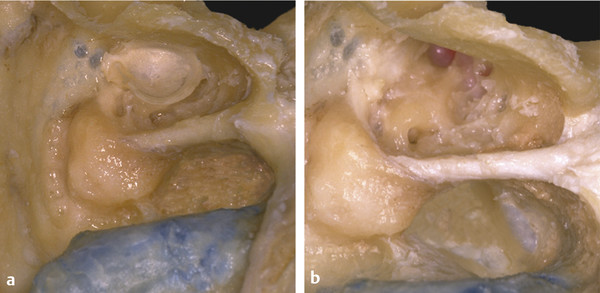
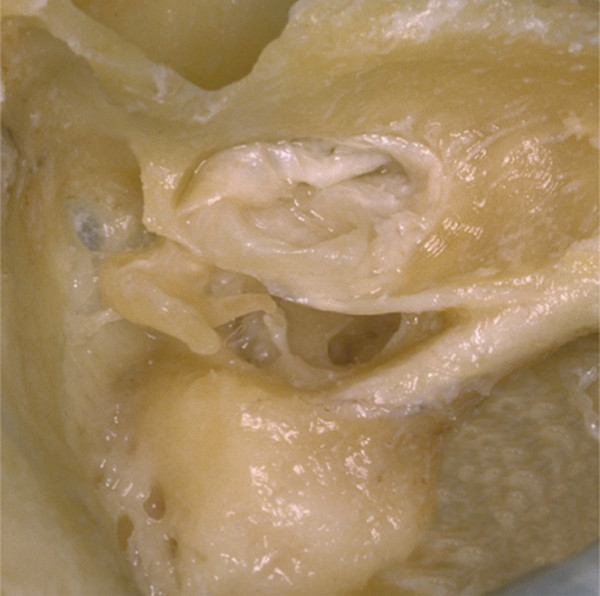
35.2 Patient Selection
35.3 Surgical Technique
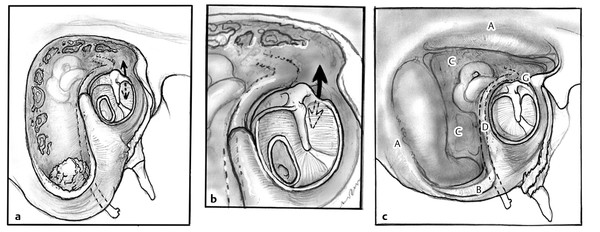
35.3.1 Canal Wall-Down Cholesteatoma Exposure
35.3.2 Mastoidectomy and Epitympanic Dissection
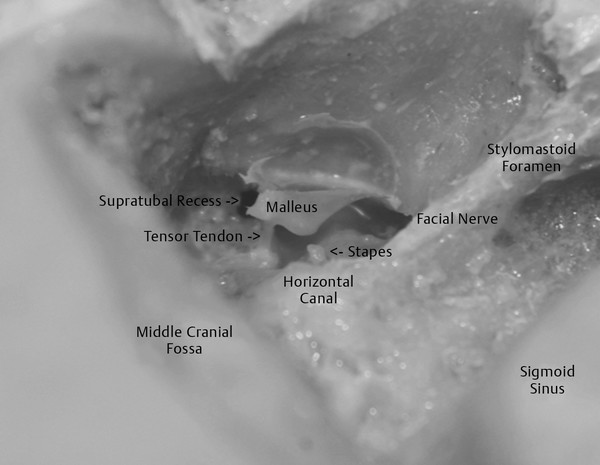
35.3.3 Lowering the Facial Ridge
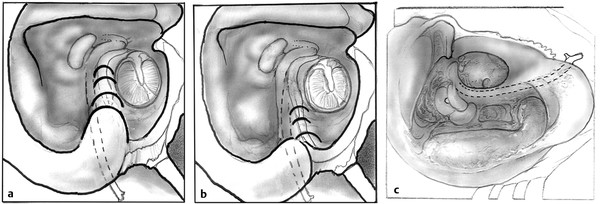
35.3.4 Contouring the Tympanic Bone Junction with the Mastoid Cavity
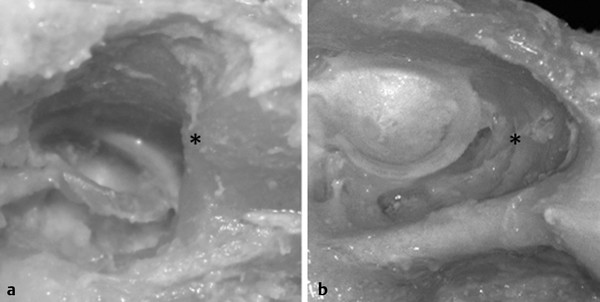
Stay updated, free articles. Join our Telegram channel

Full access? Get Clinical Tree


